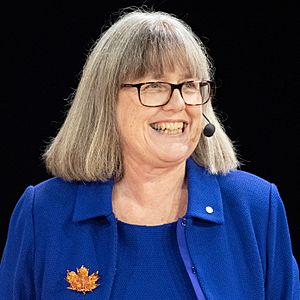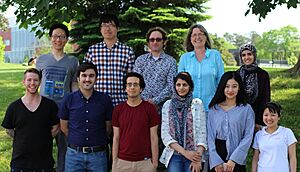Donna Strickland facts for kids
Quick facts for kids
Donna Strickland
|
|
|---|---|

Strickland in 2018
|
|
| Born |
Donna Theo Strickland
27 May 1959 Guelph, Ontario, Canada
|
| Alma mater |
|
| Spouse(s) | Doug Dykaar |
| Awards | Nobel Prize (2018) |
| Scientific career | |
| Institutions |
|
| Thesis | Development of an Ultra-Bright Laser and an Application to Multi-photon Ionization (1988) |
| Doctoral advisor | Gérard Mourou |
Donna Theo Strickland, born on May 27, 1959, is a Canadian scientist who studies light and lasers. She is a leader in creating powerful, short bursts of laser light.
In 2018, she won the Nobel Prize in Physics with Gérard Mourou. They won for inventing a special way to make lasers super powerful, called chirped pulse amplification. She is a professor at the University of Waterloo in Ontario, Canada.
She has also served as a leader for Optica, a major group for optics and photonics. In 2018, she was named one of BBC's 100 Women. A science prize in Canada is now named after her.
Early Life and Education
Growing Up in Canada
Donna Strickland was born on May 27, 1959, in Guelph, Ontario, Canada. Her mother, Edith J. Strickland, was an English teacher. Her father, Lloyd Strickland, was an electrical engineer.
After finishing high school, she chose to attend McMaster University. She was interested in lasers and how light and electricity work together. Her engineering physics program at McMaster included these topics. She was one of only three women in her class of twenty-five students.
University Studies and Laser Research
Strickland earned her Bachelor of Engineering degree in engineering physics in 1981. She then went on to study at The Institute of Optics at the University of Rochester. She received her Doctor of Philosophy degree in 1989.
For her doctoral research, she worked at the Laboratory for Laser Energetics. Her supervisor was Gérard Mourou. They worked together to solve a big problem with lasers. When laser pulses became too strong, they would damage the laser itself.
Inventing Chirped Pulse Amplification
In 1985, Strickland and Mourou developed a new method called chirped pulse amplification. This method stretches out each laser pulse before making it stronger. Then, it squeezes the pulse back to its original short length. This creates incredibly powerful, ultrashort laser pulses.
This invention allowed scientists to build smaller, high-power laser systems. These "table-top terawatt lasers" could fit on a regular lab table. This important work led to them winning the 2018 Nobel Prize in Physics.
Career and Research
Early Career in Laser Science
From 1988 to 1991, Donna Strickland was a research associate in Canada. She worked at the National Research Council of Canada. There, she worked with Paul Corkum in a group that had the world's most powerful short-pulse laser at the time.
She then worked at the Lawrence Livermore National Laboratory from 1991 to 1992. In 1992, she joined Princeton University. She became an assistant professor at the University of Waterloo in 1997. She was the first full-time female physics professor at the University of Waterloo.
Leading an Ultrafast Laser Group

Today, Strickland is a professor at the University of Waterloo. She leads a group that studies ultrafast lasers. They create high-intensity laser systems to explore how light interacts with matter. She has called herself a "laser jock." This means she enjoys the hands-on work of making lasers operate.
She explained that experimental scientists need to understand physics. But they also need to be able to make things work. Lasers were very tricky to use in the early days.
Modern Laser Applications
Strickland's recent work explores new uses for ultrafast light science. She is looking at different light colors, like mid-infrared and ultraviolet. She uses methods like two-color techniques and Raman scattering.
She also studies how high-power lasers can help with eye surgery. This includes using lasers to reshape the lens of the human eye. This can help to correct presbyopia, a common vision problem.
Professional Leadership
Strickland became a fellow of Optica in 2008. She served as its vice president in 2011 and president in 2013. She was also an editor for its journal, Optics Letters, from 2004 to 2010. She currently chairs Optica's Presidential Advisory Committee. She is also a member of the Canadian Association of Physicists.
Awards and Recognition
Major Awards and Honors
Donna Strickland has received many important awards for her work. These include:
- 1998 – Sloan Research Fellowship
- 1999 – Premier's Research Excellence Award
- 2000 – Cottrell Scholars Award
- 2008 – Fellow of The Optical Society
- 2018 – Nobel Prize in Physics
- 2019 – Golden Plate Award from the American Academy of Achievement
- 2019 – Companion of the Order of Canada
- 2019 – Honorary Fellow of The Canadian Academy of Engineering
- 2019 – Fellow of Royal Society of Canada
- 2020 – Member of the National Academy of Sciences
- 2020 – Elected a Fellow of the Royal Society (FRS)
- 2021 – Appointed to Pontifical Academy of Sciences
- 2022 – Awarded the insignia of Chevalier de la Légion d'honneur, a top French honor.
- 2022 – Awarded Honorary Member of Optica.
- 2022 – Awarded Joseph Carrier C.S.C. Science Medal from the University of Notre Dame.
- 2024 – Awarded an honorary doctor of science degree from the University of Alberta
- 2025 – Elected Corresponding Member of the Australian Academy of Science.
The Nobel Prize in Physics
On October 2, 2018, Strickland received the Nobel Prize in Physics. She shared it with her doctoral adviser, Gérard Mourou. Their work on chirped pulse amplification was recognized. Arthur Ashkin received the other half of the prize for his work on optical tweezers.
Strickland became only the third woman to win the Nobel Prize in Physics. The others were Marie Curie in 1903 and Maria Goeppert Mayer in 1963.
Strickland and Mourou published their important work in 1985. This was when Strickland was still a student. Their invention led to the development of very powerful, ultrashort light beams. These beams can make extremely precise cuts.
This technique is now used in many areas. It helps with laser micromachining and laser surgery. It is also used in medicine and basic science studies. It has allowed doctors to perform millions of corrective laser eye surgeries. Strickland said that they knew their discovery would be very important.
When she won the Nobel Prize, some people were surprised she was not yet a full professor. Strickland explained that she had "never applied" for the title. She said it did not necessarily mean a pay raise. She preferred to focus on her research. However, after winning the Nobel Prize, she did apply. She was promoted to full professor at the University of Waterloo in October 2018.
Order of Canada
In 2019, Strickland was named a Companion of the Order of Canada. This is one of Canada's highest honors for civilians.
Personal Life
Donna Strickland is married to Douglas Dykaar. He also has a doctorate in electrical engineering. They have two children. Their daughter, Hannah, is studying astrophysics at the University of Toronto. Their son, Adam, is studying comedy at Humber College. Strickland is an active member of the United Church of Canada.
See also
 In Spanish: Donna Strickland para niños
In Spanish: Donna Strickland para niños
- List of University of Waterloo people
- Women in physics

